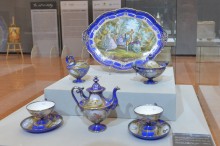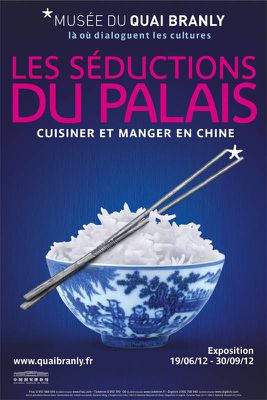02 Jul 2015 - 06 Oct 2015
Exhibition: "Tea, Art and History" | Kazakhstan

 Between 2 July and 6 October 2015, the National Museum of the Republic of Kazakhstan, an ASEMUS member, presents an exhibition entitled "Tea, Art and History".
The exhibition includes pieces of the Chitra Collection by Newby of the famous British patron and founder of the British non-commercial charity foundation N. Sethia Foundation. The Chitra Collection by Newby is located in London and is the only private collection of antiques connected to tea history. In the collection are rare and amazing pieces of art, more than 1500 invaluable works of decorative art from Europe, Asia and America. By presenting the exhibition "Tea, Art and History", Kazakhstan is the first country to host international exhibition of the Chitra Collection by Newby.
The oldest objects in the Chitra Collection include Jian ware tea bowls which were used in the widely celebrated doucha ceremonies in China and Japan during this early period. Eventually the habit of drinking tea would spread throughout Asia and the rest of the world. Dutch trading companies in particular expanded the export of Chinese and Japanese porcelain in the 17th century. Chinese porcelain was particularly prized for the purity of its color and durability; the application of intricate and costly metalwork demonstrating the high esteem in which it was held.
The collection covers continents and the millennium of mankind’s history from tea bowls of Song dynasty (the X-XIII centuries) and porcelain teapots of Satsuma to the amazing tea services of the Victorian era and magnificent accessories created in the XXI century: a scalded teapot from blue-white porcelain in Kraak style decorated with silver of Ming era, China (1368-1644), a porcelain teapot decorated with gold of Kangxi era, China (1662-1722), a teapot from the Netherlands in the baroque style (1700), a teapot made from bloodstone and decorated with gold, and a teapot of gilded silver and tray, Britain (1828), etc.
Today very few people know that only a couple of centuries ago tea was a luxury, inaccessible to mostpeople. Drink of the aristocracy and royals, tea was worth its weight in gold and stored in precious caskets under lock and key. It was served in the most refined ware from gold, silver, and the thinnest porcelain.
With origins shrouded in millennia of myth and folklore, the first written record of boiling water for tea appears relatively late, in an anecdotal tale by China’s Wang Piu titled Contract of a Youth in 59 BC. It details a contract between a servant and the author, who stipulates that the servant buy tea, boil tea and serve tea. A legend ascribes the discovery of tea much earlier to Shen Nung (2737-2697 BC) who was boiling water to drink, sheltered in the shade of a majestic tea bush. Whilst the water came to a boil, a gust of wind disturbed the branches and several tea leaves fell into the water. Whatever its true origins, one thing is certain: tea has been part of human history for millennia. With this in mind, vessels for drinking and pouring tea reached a standardization of form and design during the Tang and Song Dynasties in China.
Between 2 July and 6 October 2015, the National Museum of the Republic of Kazakhstan, an ASEMUS member, presents an exhibition entitled "Tea, Art and History".
The exhibition includes pieces of the Chitra Collection by Newby of the famous British patron and founder of the British non-commercial charity foundation N. Sethia Foundation. The Chitra Collection by Newby is located in London and is the only private collection of antiques connected to tea history. In the collection are rare and amazing pieces of art, more than 1500 invaluable works of decorative art from Europe, Asia and America. By presenting the exhibition "Tea, Art and History", Kazakhstan is the first country to host international exhibition of the Chitra Collection by Newby.
The oldest objects in the Chitra Collection include Jian ware tea bowls which were used in the widely celebrated doucha ceremonies in China and Japan during this early period. Eventually the habit of drinking tea would spread throughout Asia and the rest of the world. Dutch trading companies in particular expanded the export of Chinese and Japanese porcelain in the 17th century. Chinese porcelain was particularly prized for the purity of its color and durability; the application of intricate and costly metalwork demonstrating the high esteem in which it was held.
The collection covers continents and the millennium of mankind’s history from tea bowls of Song dynasty (the X-XIII centuries) and porcelain teapots of Satsuma to the amazing tea services of the Victorian era and magnificent accessories created in the XXI century: a scalded teapot from blue-white porcelain in Kraak style decorated with silver of Ming era, China (1368-1644), a porcelain teapot decorated with gold of Kangxi era, China (1662-1722), a teapot from the Netherlands in the baroque style (1700), a teapot made from bloodstone and decorated with gold, and a teapot of gilded silver and tray, Britain (1828), etc.
Today very few people know that only a couple of centuries ago tea was a luxury, inaccessible to mostpeople. Drink of the aristocracy and royals, tea was worth its weight in gold and stored in precious caskets under lock and key. It was served in the most refined ware from gold, silver, and the thinnest porcelain.
With origins shrouded in millennia of myth and folklore, the first written record of boiling water for tea appears relatively late, in an anecdotal tale by China’s Wang Piu titled Contract of a Youth in 59 BC. It details a contract between a servant and the author, who stipulates that the servant buy tea, boil tea and serve tea. A legend ascribes the discovery of tea much earlier to Shen Nung (2737-2697 BC) who was boiling water to drink, sheltered in the shade of a majestic tea bush. Whilst the water came to a boil, a gust of wind disturbed the branches and several tea leaves fell into the water. Whatever its true origins, one thing is certain: tea has been part of human history for millennia. With this in mind, vessels for drinking and pouring tea reached a standardization of form and design during the Tang and Song Dynasties in China.Similar content
posted on
19 May 2017
posted on
06 Aug 2014
posted on
11 Aug 2012
posted on
22 Jul 2012
posted on
31 Aug 2012
